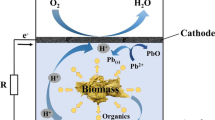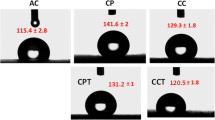Abstract
Microbial fuel cell (MFC) technology efficiently handles the two issues of pollution removal and energy generation at the same time; however, it is limited in its use due to a few fundamental constraints. The key operational constraints of the MFCs are the high cost of electrodes and membranes. To address these issues, carbonized corncob anodes were prepared, and the effect of chemical treatments such as 20% hydrogen peroxide (H2O2), 1 N NaOH, and 1 N FeCl3 on the performance of a single chamber MFC was examined. The comparison of single-chamber MFCs with the bare anode (without any chemical treatment) and the chemically treated carbonized corncob anode were performed. The comparison revealed the excellent electro-catalytic activity in MFC with 20% H2O2 treated anode, exhibiting 91% decrease in internal resistance along with 89% improvement in the maximum power density (89.7 mW/m2). The H2O2-treated anode demonstrated an increase in oxygen molecule containing functional groups which favored the electron transfer between the bacteria and electrodes. Furthermore, MFCs with 20% H2O2-treated anode resulted in 18% higher decolorization efficiency of dye wastewater than bare anode. The use of corncob as an anode material made the MFC device construction easier and economical and provided a way forward to study other cheap agro waste materials for use as anode and cathode materials.




Similar content being viewed by others
References
Sonu K, Das B. Comparison of the output voltage characteristics pattern for sewage sludge, kitchen waste and cow dung in single chamber single electrode microbial fuel cell. Indian J Sci Technol. 2016;9(30)
Bose D, Gopinath M, Vijay P (2018) Sustainable power generation from wastewater sources using microbial fuel cell. Biofuels Bioprod Bioref 12(4):559–576
Bose D, Dhawan H, Kandpal V, Vijay P, Gopinath M (2018) Bioelectricity generation from sewage and wastewater treatment using two-chambered microbial fuel cell. Int J Energy Res 42(14):4335–4344
Syed Z, Sonu K, Dongre A, Sogani M (2019) Bioelectrical systems for removal of endocrine disrupting compounds from waste water: a review. Glob J Eng 6:46–51
Do M, Ngo H, Guo W, Liu Y, Chang S, Nguyen D, Nghiem LD, Ni B (2018) Challenges in the application of microbial fuel cells to wastewater treatment and energy production: a mini review. Sci Total Environ 639:910–920
Ayyappan CS, Bhalambaal VM, Kumar S (2017) Effect of biochar on bio-electrochemical. Dye degradation and energy production. Bioresour Technol 251:165–170
Hakimelahi M, Moghaddam M, Hashemi S (2012) Biological treatment of wastewater containing an azo dye using mixed culture in alternating anaerobic/aerobic sequencing batch reactors. Biotechnol Bioprocess Eng 17:875–880
Popli S, Patel UD (2015) Destruction of azo dyes by anaerobic–aerobic sequential biological treatment: a review. Int J Environ Sci Te 12:405–420
Kim J, Kim B, An J, Lee YS, Chang IS (2016) Development of anode zone using dual-anode system to reduce organic matter crossover in membraneless microbial fuel cells. Bioresour Technol 213:140–145
Sonu K, Syed Z, Sogani M (2019) Microbial fuel cell in domestic wastewater treatment plant–an innovative step towards energy generation and waste reduction. J Sci Ind Res 78:555–557
Bajpai M, Katoch SS, Chaturvedi NK (2019) Comparative study on decentralized treatment technologies for sewage and graywater reuse–a review. Water Sci Technol 80:2091–2106
Chakraborty I, Das S, Dubey BK, Ghangrekar MM (2020) Novel low cost proton exchange membrane made from sulphonated biochar for application in microbial fuel cells. Mater Chem Phys 2020(239):122025.
Das I, Das S, Ghangrekar MM (2020) Application of bimetallic low-cost CuZn as oxygen reduction cathode catalyst in lab-scale and field-scale microbial fuel cell. Chem Phys Lett 751:137536.
Das S, Chakraborty I, Rajesh PP, Ghangrekar MM. Performance evaluation of microbial fuel cell operated with Pd or MnO2 as cathode catalyst and Chaetoceros pretreated anodic inoculum. J hazard toxic radioact waste 24(3):04020009.
Das S, Mishra A, Ghangrekar MM (2020) Production of hydrogen peroxide using various metal-based catalysts in electrochemical and bioelectrochemical systems: mini review. J hazard toxic radioact waste 24(3):06020001
Babu J, Murthy Z (2017) Treatment of textile dyes containing wastewaters with PES/PVA thin film composite nanofiltration membranes. Sep Purif Technol 183:66–72
Kumar MD, Gunasekaran M, Banu JR (2018) Generation of electricity from dye industry wastewater in dual chamber fed batch operating microbial fuel cell. Int J Adv Res Ideas Innov Technol 4:902–907
Yusuf H, Annuar MSM, Subramaniam R, Gumel AM (2019) Amphiphilic biopolyester-carbon nanotube anode enhances electrochemical activities of microbial fuel cell. Chem Eng Technol 42:566–574
Wu S, He W, Yang W, Ye Y, Huang X, Logan BE (2017) Combined carbon mesh and small graphite fiber brush anodes to enhance and stabilize power generation in microbial fuel cells treating domestic wastewater. J Power Sources 356:348–355
Kang YL, Pichiah S, Ibrahim S (2017) Facile reconstruction of microbial fuel cell (MFC) anode with enhanced exoelectrogens selection for intensifed electricity generation. Int J Hydrog Energy 42:1661–1671
Bansod B, Kumar T, Thakur R, Rana S, Singh I (2017) A review on various electrochemical techniques for heavy metal ions detection with different sensing platforms. Biosens Bioelectron 94:443–455
Zheng S, Yang F, Chen S, Liu L, Xiong Q, Yu T et al (2015) Binder-free carbon black/stainless steel mesh composite electrode for high-performance anode in microbial fuel cells. J Power Sources 284:252–257
Jayapriya J, Ramamurthy V (2013) The role of electrode material in capturing power generated in Pseudomonas catalysed fuel cells. Can J Chem Eng 92:610–614
Peng X, Chen S, Liu L, Zheng S, Li M (2016) Treated stainless steel for high performance and stable anode in microbial fuel cells. Electrochim Acta 194:246–252
Chen W, Feng H, Shen D, Jia Y, Li N, Ying X, Chen T, Zhou Y, Guo J, Zhou M (2018) Carbon materials derived from waste tires as high-performance anodes in microbial fuel cells. Sci Total Environ 618:804–809
Sciarria TP, de Oliveira MAC, Mecheri B, D'Epifanio A, Goldfarb JL, & Adani F (2020) Metal-free activated biochar as an oxygen reduction reaction catalyst in single chamber microbial fuel cells. J Power Sources 462:228183
Budai A, Wang L, Gronli M, Strand LT, Antal Jr MJ, Abiven S, Dieguez-Alonso A, Anca-Couce A, Rasse DP. Surface properties and chemical composition of corncob and miscanthus biochars: effects of production temperature and method. J Agric Food Chem 62:3791–3799
Das I, Das S, Das S, Ghangrekar MM (2021) Proficient sanitary wastewater treatment in laboratory and field-scale microbial fuel cell with anti-biofouling Cu0. 5Mn0. 5Fe2O4 as cathode catalyst. J Electrochem Soc 168(5):054519.
Syed Z, Sonu K, & Sogani M (2021) Cattle manure management using microbial fuel cells for green energy generation. Biofuels Bioprod Bioref
Jessica K, Souren S, Sky M, Jocelyn HG (2012) Microbial fuel cell biofilm characterization with thermogravimetric analysis on bare and polyethyleneimine surface treated carbon foam anodes. J Power Sources 210:122–128
Yu Z, Yan M, Ting L, Zhishuai D, Yuxue W (2018) Modification of carbon felt anodes using doubleoxidant HNO3/H2O2 for application in microbial fuel cells. RSC Adv 8:2059–2064
Das S, Das S, Ghangrekar MM (2021) Application of TiO2 and Rh as cathode catalyst to boost the microbial electrosynthesis of organic compounds through CO2 sequestration. Process Biochem 101:237–246
Li J, Zhang J, Ye D, Zhu X, Liao Q, Zheng J (2014) Optimization of inner diameter of tubular bamboo charcoal anode for a microbial fuel cell. Int J Hydrog Energy 39:19242–19248
Saini S, Arora S, Singh BP, Katnoria JK, Kaur I (2018) Nitrilotriacetic acid modified bamboo charcoal (NTA-MBC): an effective adsorbent for the removal of Cr (III) and Cr (VI) from aqueous solution. J Environ Chem Eng 6:2965–2974
Cheng S, Liu H, Logan BE (2006) Increased power generation in a continuous flow MFC with advective flow through the porous anode and reduced electrode spacing. Environ Sci Technol 40:2426–2432
Kondaveeti S, Moon JM, Min B (2017) Optimum spacing between electrodes in an air-cathode single chamber microbial fuel cell with a low-cost polypropylene separator. Bioprocess Biosyst Eng 40:1851–1858
Hindatua Y, Annuara M, Gumelc A (2017) Mini-review: anode modification for improved performance of microbial fuel cell. Renew and Sustain Energy Reviews 73:236–248
Pandit S, Ghosh S, Ghangrekar MM, Das D (2012) Performance of an anion exchange membrane in association with cathodic parameters in a dual chamber microbial fuel cell. Int J Hydrogen Energ 37:9383–9392
Park Y, Nguyen VK, Park S, Yu J, Lee T (2018) Effects of anode spacing and flow rate on energy recovery of flat-panel air-cathode microbial fuel cells using domestic wastewater. Bioresour Technol 258:57–63
Lee CY, Huang Y (2013) The effects of electrode spacing on the performance of microbial fuel cells under different substrate concentrations. Water Sci Technol 68:2028–2034
Das B, Thakur S, Chaithanya MS, Biswas P (2019) Batch investigation of constructed wetland microbial fuel cell with reverse osmosis (RO) concentrate and wastewater mix as substrate. Biomass Bioenergy 122:231–237
Pan Y, Zhu T, He Z (2018) Enhanced removal of azo dye by a bioelectrochemical system integrated with a membrane biofilm reactor. Ind Eng Chem Res 13:31–49
Mu Y, Rabaey K, Rozendal R, Yuan Z, Keller J (2009) Decolorization of azo dyes in bioelectrochemical systems. Environ Sci Technol 43:5137–5143
Sun J, Hu Y, Bi Z, Cao Y (2009) Simultaneous decolorization of azo dye and bioelectricity generation using a microfiltration membrane air-cathode single-chamber microbial fuel cell. Bioresour Technol 100:3185–3192
Solanki K, Subramanian S, Basu S (2013) Microbial fuel cells for azo dye treatment with electricity generation: a review. Bio Tech 131:564–571
Fernando E, Keshavarz K, Kyazze G (2014) Complete degradation of the azo dye acid orange-7 and bioelectricity generation in an integrated microbial fuel cell, aerobic two-stage bioreactor system in continuous flow mode at ambient temperature. Bioresour Technol 156:155–162
Koupaie, E. H., Moghaddam, M. A., & Hashemi, S. H. (2012). Investigation of decolorization kinetics and biodegradation of azo dye Acid Red 18 using sequential process of anaerobic sequencing batch reactor/moving bed sequencing batch biofilm reactor. Int Biodeterior Biodegrad 71:43–49
Fernando E, Keshavarz T, Kyazze G (2014) External resistance as a potential tool for influencing azo dye reductive decolourisation kinetics in microbial fuel cells. Internat Biodeter & Biodegrad 89:7–14
Huang W, Chen J, Hu Y, Chen J, Sun J, Zhang L (2017) Enhanced simultaneous decolorization of azo dye and electricity generation in microbial fuel cell (MFC) with redox mediator modified anode. Int J of Hydrogen Energy 42(4):2349–2359
Oon YS, Ong SA, Ho LN, Wong YS, Oon YL, Lehl HK, Thung WE, Nordin N. Microbial fuel cell operation using monoazo and diazo dyes as terminal electron acceptor for simultaneous decolourisation and bioelectricity generation. J Hazard Mater 325:170–177
Bakhshian S, Kariminia HR, Roshandel R (2011) Bioelectricity generation enhancement in a dual chamber microbial fuel cell under cathodic enzyme catalyzed dye decolorization. Bio Tech 102(12):6761–6765
Savizi ISP, Kariminia HR, Bakhshian S (2012) Simultaneous decolorization and bioelectricity generation in a dual chamber microbial fuel cell using electropolymerized-enzymatic cathode. Environ Sci Technol 46:6584–6593
Author information
Authors and Affiliations
Corresponding author
Ethics declarations
Conflict of interest
The authors declare no competing interests.
Additional information
Publisher's note
Springer Nature remains neutral with regard to jurisdictional claims in published maps and institutional affiliations.
Highlights
• Design of microbial fuel cell using waste material
• Energy positive treatment of dye wastewater
• Optimization of operational parameters for enhancing dye degradation and power output
Rights and permissions
About this article
Cite this article
Sonu, K., Sogani, M., Syed, Z. et al. Improved degradation of dye wastewater and enhanced power output in microbial fuel cells with chemically treated corncob anodes. Biomass Conv. Bioref. 14, 375–386 (2024). https://doi.org/10.1007/s13399-021-02254-7
Received:
Revised:
Accepted:
Published:
Issue Date:
DOI: https://doi.org/10.1007/s13399-021-02254-7




